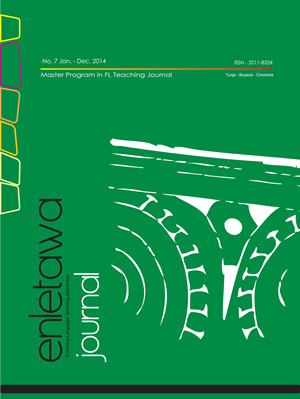Fostering reflection in the EFL classroom

Abstract
This article shares a pedagogical experience that attempted to foster reflective and interactive activities in our English lessons development. Besides, it describes some of the resources that learners used to express their ideas critically. From our research experience, it was evidenced that teachers focused
mainly in achieving students’ linguistic development. The main discussion of this study refers to the necessity of implementing new perspectives of teaching where language is taken as a social practice to foster reflective thinking through our pedagogical practices. Therefore, we as teachers should generate a confident
environment in order to promote students’ reflection and interaction in a spontaneous way. Those learning opportunities are
References
- Barry, V. (1984). Critical Thinking-What is and what is not? Invitation to critical Thinking. New York: CBS College Publishing.
- Bean, J. (2001) Engaging Ideas: The Professor’s Guide to Integrating Writing, Critical Thinking, and Active Learning in the Classroom. San Francisco: Jossey- Bass.
- Cheong, C. and Cheung, W. (2008) On line discussion on Critical Thinking Skills: A case study in Singapore Secondary School [Adobe digital Editions Version]. Retrieved fromhttp://www.ascilite.org.au/ajet/ajet24/cheong.pdf
- Cohen, L. andManion, L. (1996). Research methods in education. Case studies. Routledge. New York.
- De Tezanas, A. (1998). Una etnografía de la etnografía. Bogotá: Ediciones Antropos.
- Dovros, N. and Makrakis, V. ( 2012). Transforming the classroom into a
- reflective community: a blended learning instructional approach. Journal of Teacher Education for Sustainability .vol. 14.
- Ferrero, R. (2005). Estrategias Didácticas del Aprendizaje Cooperativo. El constructivismo social: una nueva forma de enseñar y aprender. Trillas
- Freeman, D. & Freeman, Y. (1994).Between Worlds. Access to the Second Language Acquisition. Heinemann Portsmouth, NH.
- Hakuta, K. (1986). Mirror of the Language: the Debate on Bilingualism. New York: Basic Books.
- Halliday, M. (1979). El lenguaje como semiótica Social. La interpretación social del lenguaje y del significado. México. Fondo de Cultura Económica
- Harris, S. (2012). Thumbs up. Philosophy. Richmond. United Kingdom
- Kramsch, C. (1994). Foreign languages for a global age. ADFL Bulletin.
- Krathwohl, D. (1999). ARevision of Bloom´s Taxonomy: An Overview. Theory into practice.
- Krauss, R. & Chiu, C. (1993). Language and Social Behavior. The handbook of social psychology. (4h ed.), Vol. 2. (pp. 41-88).
- Boston: McGraw-Hill.
- Mulnix, J. (2012).Thinking Critically about Critical Thinking. Educational Philosophy and theory. Vol 44, N°5.
- Pineda, C. (2004). Critical Thinking in the EFL Classroom: The Search for a Pedagogical Alternative to Improve English Learning. IKALA, Revista de Lenguaje y Cultura.
- Rovingrepairbot (2010). Sidney the Elephant -the littlest bully. Retrieved fromhttp://www.youtube.com/watch?v=MMCrB9NTuuY
- VanGelder, T. (2001). Dynamic approaches to cognition. In Wilson, Robert A.
- Whorf, B. L. (1956). Language, Thought, and Reality: Selected Writings of Benjamin LeeWhorf. Ed. John B. Carroll. Cambridge, MA: MIT Press.